|
Canku Ota |
|
(Many Paths) |
|
An Online Newsletter Celebrating Native America |
|
December 30, 2000 - Issue 26 |
|
|
|
The Frog and The Crane |
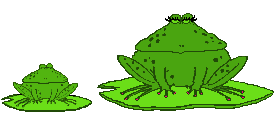 In the heart
of the woods there lay a cool, green pond. The shores of the pond were set with ranks of tall bulrushes that waved
crisply in the wind, and in the shallow bays there were fleets of broad water lily leaves. Among the rushes and
reeds and in the quiet water there dwelt a large tribe of Frogs. In the heart
of the woods there lay a cool, green pond. The shores of the pond were set with ranks of tall bulrushes that waved
crisply in the wind, and in the shallow bays there were fleets of broad water lily leaves. Among the rushes and
reeds and in the quiet water there dwelt a large tribe of Frogs.On every warm night of spring, the voices of the Frogs arose in a cheerful chorus. Some voices were low and deep---these were the oldest and wisest of the Frogs; at least, they were old enough to have learned wisdom. Some were high and shrill, and these were the voices of the little Frogs who did not like to be reminded of the days when they had tails and no legs. "Kerrump! kerrump! I'm chief of this pond!" croaked a very large bullfrog, sitting in the shade of a water lily leaf. "Kerrump! kerrump! I'm chief of this pond!" replied a hoarse voice from the opposite bank. "Kerrump! kerrump! I'm chief of this pond!" boasted a third old Frog from the furthest shore of the pond.  Now a long-legged white Crane was standing near by, well hidden by the coarse grass that grew at
the water's edge. He was very hungry that evening, and when he heard the deep voice of the first Bullfrog he stepped
briskly up to him and made a quick pass under the broad leaf with his long, cruel bill. The old Frog gave a frightened
croak, and kicked violently in his efforts to get away, while over the quiet pond, splash! splash! went the startled
little Frogs into deep water. Now a long-legged white Crane was standing near by, well hidden by the coarse grass that grew at
the water's edge. He was very hungry that evening, and when he heard the deep voice of the first Bullfrog he stepped
briskly up to him and made a quick pass under the broad leaf with his long, cruel bill. The old Frog gave a frightened
croak, and kicked violently in his efforts to get away, while over the quiet pond, splash! splash! went the startled
little Frogs into deep water.The Crane almost had him, when something cold and slimy wound itself about one of his legs. He drew back for a second, and the Frog got safely away! But the Crane did not lose his dinner after all, for about his leg was curled a large black water snake, and that made a fair meal. 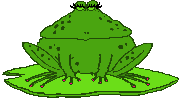 Now he rested awhile on one leg, and listened. The first Frog was silent, but from the opposite
bank the second Frog croaked boastfully: Now he rested awhile on one leg, and listened. The first Frog was silent, but from the opposite
bank the second Frog croaked boastfully:"Kerrump! kerrump! I'm chief of this pond!" The Crane began to be hungry again. He went round the pond without making any noise, and pounced upon the second Frog, who was sitting up in plain sight, swelling his chest with pride, for he really thought now that he was the sole chief of the pond. The Crane's head and most of his long neck disappeared under the water, and all over the pond the little Frogs went splash! splash! into the deepest holes to be out of the way. 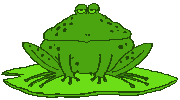 Just as he had the Frog by one hind leg, the Crane saw something that made him let go, flap his
broad wings and fly awkwardly away to the furthest shore. It was a mink, with his slender brown body and wicked
eyes, and he had crept very close to the Crane, hoping to seize him at his meal! So the second Frog got away too;
but he was so dreadfully frightened that he never spoke again. Just as he had the Frog by one hind leg, the Crane saw something that made him let go, flap his
broad wings and fly awkwardly away to the furthest shore. It was a mink, with his slender brown body and wicked
eyes, and he had crept very close to the Crane, hoping to seize him at his meal! So the second Frog got away too;
but he was so dreadfully frightened that he never spoke again.After a long time the Crane got over his fright and he became very hungry once more. The pond had been still so long that many of the Frogs were singing their pleasant chorus, and above them all there boomed the deep voice of the third and last Bullfrog, saying: "Kerrump! kerrump! I'm chief of this pond!" T 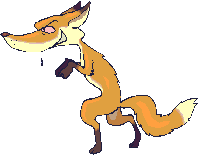 he Crane stood not far from the boaster, and he determined to silence him once for all. The next
time he began to speak, he had barely said "Kerrump!" whe the Crane had him by the leg. He croaked and
struggled in vain, and in another moment he would have gone down the Crane's long throat. But just then a Fox crept
up behind the Crane and seized him! The Crane let go the Frog and was carried off screaming into the woods for
the Fox's supper. So the third Frog got away; but he was badly lamed by the Crane's strong bill, and he never dared
to open his mouth again. he Crane stood not far from the boaster, and he determined to silence him once for all. The next
time he began to speak, he had barely said "Kerrump!" whe the Crane had him by the leg. He croaked and
struggled in vain, and in another moment he would have gone down the Crane's long throat. But just then a Fox crept
up behind the Crane and seized him! The Crane let go the Frog and was carried off screaming into the woods for
the Fox's supper. So the third Frog got away; but he was badly lamed by the Crane's strong bill, and he never dared
to open his mouth again.It is not a wise thing to boast too loudly. |
|
Print and color your own crane and fox |
|
Make your own crane from origami How to Fold a Paper Crane |
|
|
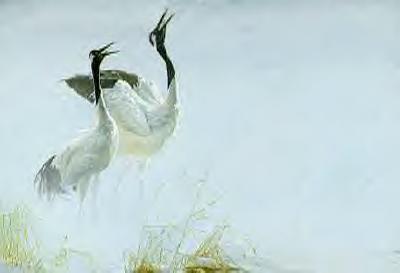 Whooping
cranes are magnificent birds, unique to North America. They are the tallest bird in North America, standing nearly
5 feet tall, with a long, sinuous neck and long legs. They have red-and-black heads with long, pointed beaks. Their
snow-white body feathers are accented by jet-black wing tips (visible only when the wings are extended). Their
wingspan measures 7 feet across. During the fall, juveniles have rusty brown plumage with some white adult feathers
just beginning to appear. Whoopers fly with a slow wingbeat, straight neck, and legs trailing out beyond their
tail. Whooping
cranes are magnificent birds, unique to North America. They are the tallest bird in North America, standing nearly
5 feet tall, with a long, sinuous neck and long legs. They have red-and-black heads with long, pointed beaks. Their
snow-white body feathers are accented by jet-black wing tips (visible only when the wings are extended). Their
wingspan measures 7 feet across. During the fall, juveniles have rusty brown plumage with some white adult feathers
just beginning to appear. Whoopers fly with a slow wingbeat, straight neck, and legs trailing out beyond their
tail.Two legally hunted wildlife species, sandhill cranes and snow geese, are similar in appearance to whooping cranes. The sandhill crane is gray and smaller with a wingspan of 5 feet, but sometimes appear whitish in bright light. Sandhill cranes occur in flocks of 2 to hundreds. Snow geese and white pelicans are white with black wingtips (geese) or wing edges (pelicans) but both have short legs that do not extend beyond the tail when in flight. Snow geese generally occur in large flocks, are much smaller than whooping cranes, and fly with a rapid wingbeat. White pelicans fly with their neck folded and can be distinguished by their large yellow bill. Herons and egrets also fly with their long necks folded. Natural History 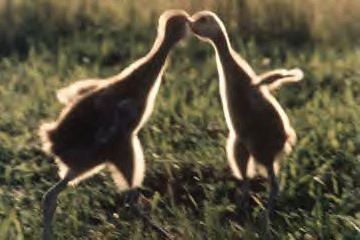 Our fascination with whoopers partially results from their loud vocalizations and elaborate courtship
rituals which help strengthen pair bonds. Courtship behavior consists of calling, wing flapping, head bowing, and
tremendous leaps into the air by both birds. These dances begin in late winter as a prelude to mating, but may
occur at other times as whoopers defend their territories or play. Our fascination with whoopers partially results from their loud vocalizations and elaborate courtship
rituals which help strengthen pair bonds. Courtship behavior consists of calling, wing flapping, head bowing, and
tremendous leaps into the air by both birds. These dances begin in late winter as a prelude to mating, but may
occur at other times as whoopers defend their territories or play.Whooping cranes mate for life but will re-mate following the death of a mate. Whoopers may survive up to 25 years in the wild and 35 to 40 years in captivity. They generally begin to produce eggs when 4 ro 5 years old and lay two eggs but seldom are successful in rearing more than one chick. The nests are built on small islands of bulrushes, cattails and sedges. Wetlands are the main source of food for whoopers where they find crabs, crayfish, frogs, and large insects but rarely fish. In the uplands they feed on small grains, acorns and berries. At night they stand (roost) in shallow water where they are safe from coyotes and bobcats. Fall migration begins in September. The cranes normally migrate as a single pair, family group, or in small flocks, sometimes accompanying sandhill cranes. Flocks of up to 10 subadults have been observed feeding at stopover areas. They migrate during the day and make regular stops to feed and rest. They prefer to stop at isolated areas away from human disturbance. By sometime in November they are on their wintering grounds. Spring migration begins in early March and they reach the breeding grounds in May. The Rocky Mountain Population: 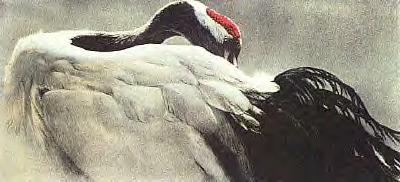 There are 3 birds in a flock that winters in New Mexico and spends the summers in Idaho and Wyoming.
These birds are the survivors of an experiment to start a new migratory wild population. Whooping crane eggs were
placed in sandhill crane nests in Idaho. The foster parents reared the whooping cranes and taught them how to survive
in the wild, when to migrate and where to spend the winter. The population peaked at 33 in 1985, but these birds
never paired and produced young. The absence of breeding is thought to be caused by improper sexual imprinting.
We now know that some species of birds identify their parents or foster parents as a model for their future mate.
Therefore, the foster-reared whoopers want to mate with sandhill cranes but sandhill cranes are not interested
in pairing with the whoopers. There are 3 birds in a flock that winters in New Mexico and spends the summers in Idaho and Wyoming.
These birds are the survivors of an experiment to start a new migratory wild population. Whooping crane eggs were
placed in sandhill crane nests in Idaho. The foster parents reared the whooping cranes and taught them how to survive
in the wild, when to migrate and where to spend the winter. The population peaked at 33 in 1985, but these birds
never paired and produced young. The absence of breeding is thought to be caused by improper sexual imprinting.
We now know that some species of birds identify their parents or foster parents as a model for their future mate.
Therefore, the foster-reared whoopers want to mate with sandhill cranes but sandhill cranes are not interested
in pairing with the whoopers.The U.S. Fish and Wildlife Service is now experimenting with techniques of introducing captive-reared whooping cranes (imprinted on their own species) into the wild where they will learn an appropriate migration route. In cranes, migration behavior must be learned. Seven whoopers have been captive-reared in Idaho and trained to follow an ultra-light aircraft. They will follow the plane (mimicking migration following their parents) to Bosque del Apache National Wildlife refuge in the fall of 1997. The whoopers will winter at the refuge and then should migrate back to Idaho in the spring, on their own. If this experiment is successful, the technique may be used to introduce a new migratory flock to the eastern United States and Canada. No more whoopers will be introduced into the Rocky Mountain population. Viewing, Protection, and Reporting Sightings  There are three places in the United States where whoopers can reliably be viewed. Whooping cranes
are a major tourist attraction on the Texas coast in winter and annual festivals are held in association with their
presence in Colorado and New Mexico. Tour boats offer trips from Rockport, Texas to view cranes along the Gulf
Intracoastal Waterway. A fall festival of the cranes is held in Socorro, New Mexico and at nearby Bosque del apache
National Wildlife Refuge where the main attraction is the opportunity to see whooping cranes and sandhill cranes.
The Monte Vista Crane Festival is held in March in Monte Vista, Colorado when the cranes stops in the San Luis
Valley enroute north to summering areas in Idaho and Wyoming. There are three places in the United States where whoopers can reliably be viewed. Whooping cranes
are a major tourist attraction on the Texas coast in winter and annual festivals are held in association with their
presence in Colorado and New Mexico. Tour boats offer trips from Rockport, Texas to view cranes along the Gulf
Intracoastal Waterway. A fall festival of the cranes is held in Socorro, New Mexico and at nearby Bosque del apache
National Wildlife Refuge where the main attraction is the opportunity to see whooping cranes and sandhill cranes.
The Monte Vista Crane Festival is held in March in Monte Vista, Colorado when the cranes stops in the San Luis
Valley enroute north to summering areas in Idaho and Wyoming.Sandhill crane and snow geese hunters in Idaho, Wyoming, Utah, Colorado, and New Mexico should be on the look out at all times during the various hunts for whooping cranes. Whooping cranes are protected by the Endangered Species Act of the United States. The Act authorizes payment of up to $2500 for information leading to the arrest and conviction of any person harassing, shooting, or attempting to take a whooping crane. Contact your local State Game and Fish Office, or the U.S. Fish and Wildlife Service for further information, or to report possible violations. If you see whooping cranes during the migration periods of March-May or September-November, please report the observation to your State Game and Fish Office or to the U.S. Fish and Wildlife Service, Grand Island, Nebraska phone (308)382-6468. |
|
Division of Ecological Services |
|
Aransas National Wildlife Refuge |
|
U.S. Fish and Wildlife Service |
|
All About Whooping Cranes |
|
International Crane Foundation Education
Resources |
|
National Wildlife Foundation Cranes |
|
|
|
|
| Canku Ota is a free Newsletter celebrating Native America, its traditions and accomplishments . We do not provide subscriber or visitor names to anyone. Some articles presented in Canku Ota may contain copyright material. We have received appropriate permissions for republishing any articles. Material appearing here is distributed without profit or monetary gain to those who have expressed an interest. This is in accordance with Title 17 U.S.C. section 107. |
|
Canku Ota is a copyright © 2000 of Vicki Lockard and Paul Barry. |
|
The "Canku Ota - A Newsletter Celebrating Native America" web site and its design is the |
|
Copyright © 1999, 2000 of Paul C. Barry. |
|
All Rights Reserved. |